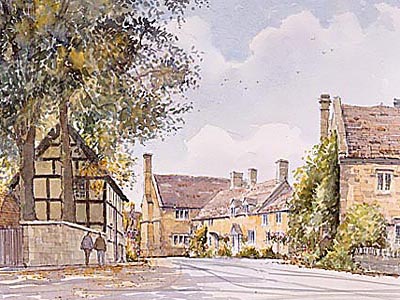- You are here:
- Home
- >>
- In Our Area
- >>
- Local Towns + Countryside
 |
Stanton Village - a watercolour by John Davis© |
Cotswold Stone
The famous stone which colours the landscape, the homes and the buildings is limestone, found commonly across England, but is dramatically demonstrated in the Cotswolds. Here the limestone is oolitic (egg-stone' in Greek), which is soft when first exposed and continues to harden on contact with the air - a perfect building material, that can be readily sawn on quarying. It was used extensively in the Middle Ages - the finest example being St Paul's Cathedral, London.
The Thatched and Stone Roofs

Homes in the Cotswolds reflect the countryside and the material available. In the past farmers needed thatchers for their corn and hay ricks. Whilst the art of thatching has changed little over the centuries it is now carried out by specialists. The thatcher still uses the tools they always used: mallet, for driving, needles for sewing the tarred string, reed-holder, for holding the bundles.
More commonly throughout the Cotswolds are the traditional stone slate roofs. These are found from Chipping Campden in the north to bath in the South. The stone are fixed to the roof by wooden pegs driven through the hole at the top of each slate.
These type of roofs are thought to last upwards of 200 years if kept in good condition and free of moisture and moss.
The slates are produced by storing the stone wet, by laying wet sacks over them. The split well naturally, but are thick, thus requiring oak beams in the roofs to support the weight.



